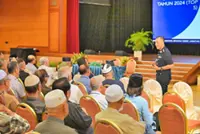Exercise is an important part of healthy ageing, but particularly so in the presence of osteoporosis, where it can help protect the bones. — TNS
Congratulations to your mother for remaining active as she ages.
Exercise is an important part of healthy ageing, but particularly so in the presence of osteoporosis.
Already a subscriber? Log in
Save 30% OFF The Star Digital Access
Cancel anytime. Ad-free. Unlimited access with perks.





